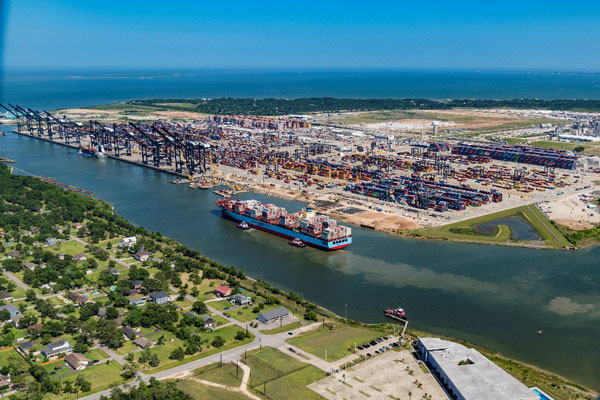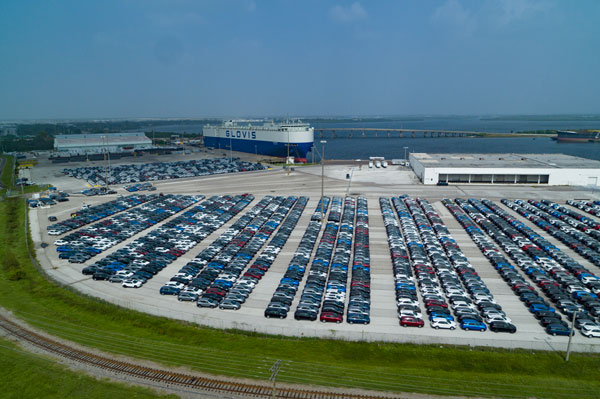America’s seaports typically stay out of the limelight until something bad happens. But in the rare event of a horrific tragedy such as the collapse of the Francis Scott Key Bridge in Baltimore, the impact of U.S. ports on global supply chains becomes front-page news.
In the case of America’s Gulf Coast ports, all eyes now turn to the aftermath of the tragedy that claimed the lives of six construction workers and upended shipping lanes in and out of the Port of Baltimore in late March.
While most shipments will be redirected to other Atlantic ports such as those in Richmond, Norfolk, Charleson, Savannah, New Jersey and Jacksonville, experts contacted by Site Selection say that the Gulf Coast ports of Texas, Louisiana, Mississippi, Alabama and Florida may experience after-effects as well.
“The collapse of the Francis Scott Key Bridge in Baltimore will not have a significant impact on trade between the U.S. and Europe or the global supply chain in general since much of its tonnage can be easily diverted to alternate East Coast ports like New York/New Jersey, Norfolk, Philadelphia and Charleston,” says John H. Boyd Jr., principal with The Boyd Company Inc., a site consulting firm based in New Jersey. “However, certain segments of trade that rely heavily on the Baltimore port, like auto imports and U.S. exports of coal and imports of cobalt, will be impacted greatly. I understand that coal export terminals of CSX and Consol are now blocked, with Wilmington being a close-in option.”
One impact, which could benefit Gulf Coast ports, is what happens next in Mexico.
“Mexico is a growing force in auto production,” says Boyd. “Elon Musk is the most recent to announce a major plant near Monterrey for Tesla. Mexican auto imports could be diverted to trucks through the Texas border, particularly via Port Laredo. Gulf Coast ports may play a role here as well.”
Other experts see Gulf Coast ports taking on a larger role in the U.S. economy.
“Because the Baltimore port may be closed for an extended period, you might see some suppliers reroute to the Gulf Coast, but the logistics suggest that it probably will not be a huge shift,” says Dr. Ray Perryman, a Texas-based economist.
Investment Records Set in Louisiana
One thing we can expect to see more of is further energy development at or near Gulf Coast ports. An example is the Port of Lake Charles in Southwest Louisiana. On Feb. 29, Lake Charles Methanol II LLC said it plans to invest $3.24 billion to build a factory to produce low-carbon-intensity methanol and other chemicals at the Port of Lake Charles.
If the company secures all needed approvals, the project will create 123 jobs in Calcasieu Parish at an average annual wage of $135,955. More than 2,300 construction jobs will be generated during peak building.
“The project will deliver substantial tangible economic benefits to local communities while providing an environmentally beneficial blue methanol product to facilitate the transition to low-carbon chemicals and fuels,” LCM President Don Maley said.
The project must first undergo a FEED study and regulatory permitting. A final investment decision is expected by mid-2024. Construction would take another three and a half years, which would allow for commercial operation to begin in late 2027.
The project qualifies for a Louisiana Economic Development FastStart worker training incentive and a $5 million state grant for infrastructure. The company is also expected to apply for Louisiana’s Industrial Tax Exemption and Quality Jobs programs.
George Swift, president and CEO of the Southwest Louisiana Economic Development Alliance, calls the project “a welcome addition to our regional industrial base, and the numerous jobs it will create will be another boon for Southwest Louisiana’s workforce.”
 The Port of Lake Charles has been the main driver in Southwest Louisiana landing more than $100 billion in new industrial development.
The Port of Lake Charles has been the main driver in Southwest Louisiana landing more than $100 billion in new industrial development.
Photo courtesy of Port of Lake Charles
Swift has seen more than $100 billion in port-driven investment in Greater Lake Charles during his 20-year run as the region’s chief economic developer. “The LNG [liquefied natural gas] industry has transformed several areas along the Gulf Coast, especially in Lake Charles, Corpus Christi and Port Arthur,” he says. “There has been a huge shift in manufacturing and interest in being in the South. We have five ports in our five-parish region. Each has its own specialty. Each has a role to play in the Gulf Coast economy.”
Michael Hecht, president and CEO of Greater New Orleans Inc., agrees.
“This is all about the competition between New Orleans and Mobile. This is about who will serve the middle of the country.”
— Michael Hecht, President & CEO, Greater New Orleans Inc., on the planned new Louisiana International Terminal
“The biggest port story in Louisiana today is the beginning of the Louisiana International Terminal project that is being built downriver from the main port facility in New Orleans,” he says. “This is a $2 billion project that will enable Louisiana to go back to the future in ports. This is why we purchased Louisiana from Napoleon over 200 years ago.”
Because the new Panamax ships are too tall to fit under the Crescent City Bridge, the new international terminal will expedite the transition to containerization. “This is all about the competition between New Orleans and Mobile,” says Hecht. “This is about who will serve the middle of the country. The Port of Mobile a couple of years ago surpassed the Port of New Orleans in container volume. That is why you have seen new Amazon and Walmart distribution hubs opens in southern Alabama.”
Hecht says that construction on the new terminal is set to begin in 2025, with the opening of the first berth slated for 2028.
“This will result in 18,000 new direct and indirect jobs in Louisiana by 2050,” he adds. “We are in a new industrial renaissance. Many large investment projects are moving toward their final investment decision. We’re seeing tens of billions of dollars in proposed new energy projects in South Louisiana. These include investments into carbon capture technology; biofuels; battery manufacturing; and offshore wind manufacturing.”
The largest project on the docket in Greater New Orleans now is Venture Global. At $21.4 billion, this LNG complex in Plaquemine Parish is the largest privately financed energy project in Louisiana history, says Hecht.
Not even the Biden Administration’s recent pause on approving any new LNG export terminals is slowing down this investment surge, says Hecht. “We have seen no direct impact of the Biden decision to pause new LNG terminals,” he says. “But it is causing a lot of consternation due to the mixed signals it is sending to the market.”
Overall, he adds, “the clean energy transition is real. It is not going away. It is being spurred by investment and regulation. Louisiana is well positioned for this transition.”
 The Port of Houston recently posted unprecedented February trade volumes. Just-released U.S. Army Corps of Engineers waterborne commerce statistics for 2022 ranked the port the busiest in the nation, with six other Gulf Coast ports in the top 10.
The Port of Houston recently posted unprecedented February trade volumes. Just-released U.S. Army Corps of Engineers waterborne commerce statistics for 2022 ranked the port the busiest in the nation, with six other Gulf Coast ports in the top 10.
Photo courtesy of Port of Houston
Swift: You Can Never Have Enough Sites
Swift says the region’s ports became a major player in the global economy when Cheniere opened its first LNG plant in Cameron Parish in 2016. “That was a huge win for our region,” he says. “When Cheniere opened and when SASOL started production at its $14 billion ethane cracker here, that’s when our area began its extensive surge in growth.”
Swift says the ports along the Gulf Coast work in harmony because each port plays to its own strengths. “The U.S. Department of Commerce has decided what each port will do,” he says. “The Port of Houston does containers. The Port of Lake Charles does not do containers. It is a breakbulk port. Lake Charles does refineries and LNG plants. The Port of New Orleans is different than these too. That is why we formed the Southwest Louisiana Port Network. That helped each port in our region know what their strengths are and how they can work together.”
Whatever happens going forward, says Swift, the new energy environment is here to stay. “LNG will drive a lot of the growth in Louisiana and Southeast Texas,” he says. “Despite the current pause, I think that delay will be lifted, and those developments will go forward. The ships and the containers will keep getting bigger. We will see more super-carriers. The South is in great shape; and the Gulf Coast will continue to be an energy-producing area. You cannot produce seafood and energy inland. Every region has something. We have energy and seafood.”
When asked what advice he would give to other port communities along the Gulf Coast, Swift says, “We should have emphasized and demanded more infrastructure on industrial sites — rail, water, sewer, utilities, power, etc. An empty field no longer works as a qualified industrial site. We now have 11 certified sites in our region. We could have used 25. I should have pushed for more infrastructure.”

